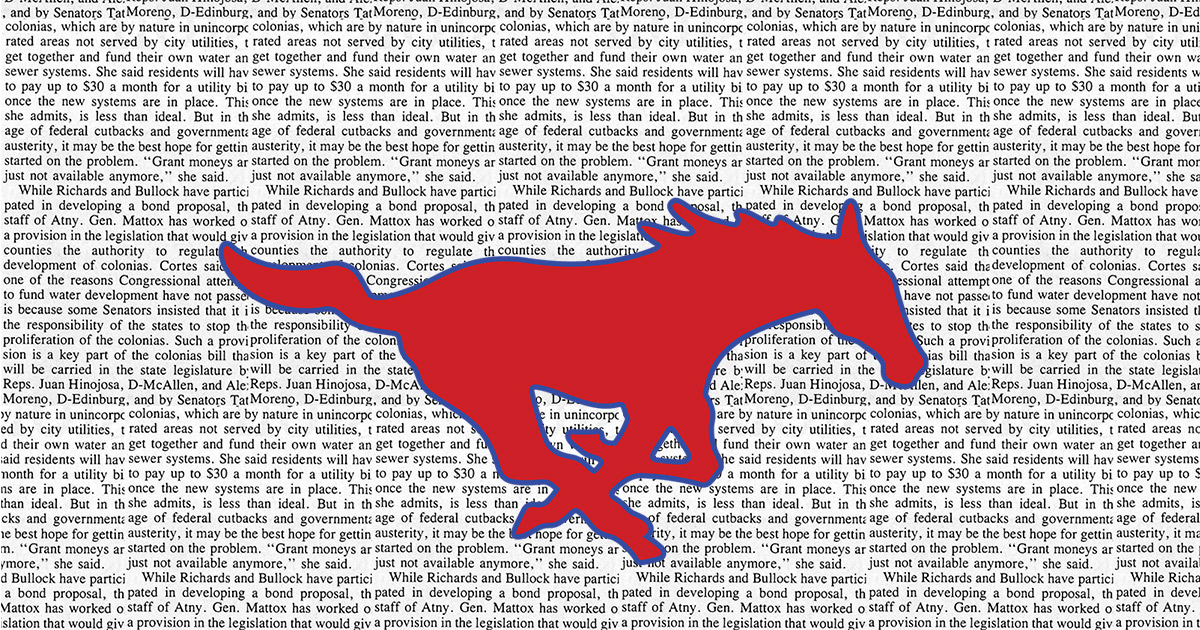
SMU Just Lost Its Independent Student Newspaper. Is Your College Next?
Between declining revenue and interfering administrators, student-run media is facing an existential crisis.

Declining advertising. Difficulties making the transition from print to digital. A looming corporate takeover. No, this isn’t the Austin American-Statesman, the Denver Post or any of the countless other newspapers struggling to survive in the new media economy. It’s the SMU student newspaper, The Daily Campus, which, after 103 years of independence, will be folded into the school’s journalism program at the end of May. The paper’s final print edition was published on May 9.
The move comes despite a last-ditch effort by Daily Campus alumni, led by ProPublica reporter Jessica Huseman, to preserve the paper’s independence. “I’m a national politics reporter, and the only time I’ve interviewed a president was when I was editor-in-chief of The Daily Campus,” she said. (It was George W. Bush.) “I got my first management experience at The Daily Campus. If a professor was holding my hand, I never would have learned any of those lessons. So it’s upsetting to me that the journalism school is going to take that away from students.”
Huseman and other alumni learned in April that the board of directors of the Student Media Company, the independent nonprofit that oversees The Daily Campus and the yearbook, had voted to dissolve itself due to lack of funds. In response, Huseman and Chip Stewart, another Daily Campus alum and a journalism professor at TCU, launched a group called Friends of Student Media to raise the $125,000 it would take to fund the paper for another year. Through GoFundMe and the Dallas Foundation, they raised about $38,000 in less than two weeks. But at an April 24 meeting with the Student Media Company board, the alumni were told it was too little, too late. Furious, they penned an open letter to SMU President R. Gerald Turner blaming the board for ceding editorial independence after “years of mismanagement and disinterest.” It was signed by 47 alumni, a former advertising advisor and a former student advisor.
“If there is no agreement, nothing at all prevents SMU from saying, ‘We pay for you, so take this out of your archive.’ Or, ‘Give us prior review of your stories.’”
In an emailed statement to the Observer, Turner said, “SMU is firmly committed to protecting First Amendment rights. SMU’s journalism faculty, who have worked as professionals in this field, are committed to teaching and protecting these rights and preparing students for success.”
The SMU journalism department has promised to maintain The Daily Campus as a digital-only news outlet and preserve its editorial independence. Department chairman Tony Pederson said he plans to establish an advisory board, comprising both faculty and students, to oversee the paper, and he expects that one of the board’s first acts will be to issue a “statement of principle” prohibiting censorship.
“That sounds like a public relations move by SMU,” Huseman said about the statement of principle. “It sounds aspirational, not contractual. If there is no agreement, nothing at all prevents SMU from saying, ‘We pay for you, so take this out of your archive.’ Or, ‘Give us prior review of your stories.’”
SMU does have a history of censoring student media. During the 1993-94 school year, the administration threatened to kick the paper out of its offices in the student center if the staff didn’t agree to prior review. In 2011, the administration demanded the removal of an opinion piece criticizing the school’s board of trustees. And in 2013, a pledge guaranteeing a student press “free of censorship” mysteriously disappeared from the student handbook.

At TCU, where the student newspaper is overseen by the school’s journalism department, administrators have on several occasions intervened in editorial decisions, said Stewart, the TCU journalism professor. “We’ve had times when the administration came in and said, ‘You’ve got to take this out of the archives.’ And it was not a request.”
Some student newspapers attached to journalism schools have managed to avoid censorship. The University of Texas at Austin’s Daily Texan is affiliated with the Moody College of Communication and receives some funding from the university, but retains its independence through a board of directors with a guaranteed student majority. The state’s other major public universities all have similar arrangements.
But censorship isn’t The Daily Campus alumni’s only concern. They worry that under the journalism department’s control, the paper will become “a refrigerator for the professors to display their students’ work on,” as Huseman put it. Even as an independent paper, most of The Daily Campus’ hard news reporting came from students enrolled in journalism classes, according to outgoing editor-in-chief Kylie Madry. But the student editors retained — and often exercised — the right to reject student work.
“Right now, journalism students can pitch stories they wrote for class,” Madry said. “But at the end of the day, if the story sucks, we’re not publishing it.” In March, she said, a student reporter submitted a preview of a campus event that had already taken place. When she rejected the story, the student’s journalism professor complained. “The professor was like, ‘I’m not going to give credit for it if you don’t publish it,” she recalled. The professor eventually relented and the story didn’t run.
“You cannot learn to be a reporter while a professor is holding your hand.”
The journalism department hasn’t been coy about its intentions. “We’re interested in using The Daily Campus as a teaching tool for 150 majors in journalism,” said Pederson, the department chair. “We’re going to more closely integrate our reporting classes, and produce content. … [The students] will be overseen by several of the paid staff members, but also several of the professors who teach reporting.”
To Huseman, who also teaches journalism part-time at Columbia University, this is heresy. “Student newspapers should be entirely student-run and allow students to figure out how to be reporters and editors, sometimes by making mistakes. You cannot learn to be a reporter while a professor is holding your hand.”
The Daily Campus is hardly alone. Student newspapers across the country are struggling to adapt to leaner budgets and continuing administration pressure to present a positive image. In the face of these existential threats, students and alumni are organizing. In 2013, after The Daily Texan announced it was considering cutting production days because of declining revenue, alumni created Friends of The Daily Texan to raise money and provide mentorship. The effort worked: The Daily Texan still publishes a physical newspaper five days a week. In fact, Texas’ 10 largest universities, all public, continue to publish print editions.
In April, the University of Florida’s student newspaper launched the #SaveStudentNewsrooms campaign in reaction to news about The Daily Campus. Over 100 student newspapers marked Support Student Journalism Day on April 25 by spreading awareness on social media of the plight of SMU and other colleges with endangered papers.
“Student newspapers are the primary way that the student body gets its news about what’s going on on campus,” said Drew Keller, the outgoing editor-in-chief of Rice University’s student newspaper, the Thresher, which has maintained editorial autonomy since it was founded in 1913. “Without them, all you have is the rumor mill or official announcements from the university. There is no other way of getting that information.”


